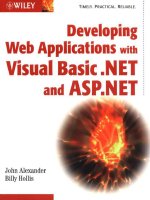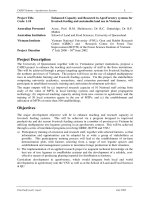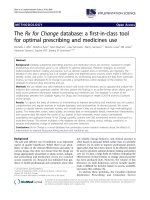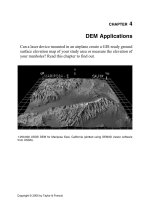Exploiting similarity patterns in web applications for enhanced genericity and maintainability
Bạn đang xem bản rút gọn của tài liệu. Xem và tải ngay bản đầy đủ của tài liệu tại đây (1.98 MB, 222 trang )
EXPLOITING SIMILARITY PATTERNS
IN WEB APPLICATIONS FOR ENHANCED
GENERICITY AND MAINTAINABILITY
DAMITH CHATURA RAJAPAKSE
(BSc.Eng (Hons), SL)
A THESIS SUBMITTED FOR THE DEGREE OF
DOCTOR OF PHILOSOPHY
SCHOOL OF COMPUTING
NATIONAL UNIVERSITY OF SINGAPORE
ii
Acknowledgments
My profound thanks are due to the following persons.
• My advisor A/P Stan Jarzabek, for the innumerable ways in which he made this thesis
possible, and for guiding me with boundless patience, never shying away when help
was needed.
• Members of my thesis committee A/P Dong Jin Song and A/P Khoo Siau Cheng for
their valuable advice throughout this journey of four years, and for spending their
valuable time in various administration tasks related to my candidature.
• Collaborators, advisors, and evaluators who gave feedback about my research: Dr.
Bimlesh Wadhwa, Dr. Irene Woon, and Prof Kim Hee-Woong (NUS), Prof. Andrea
De Lucia and Dr. Giuseppe Scanniello (Università di Salerno, Italy), Prof. Katsuro
Inoue, Dr. Shinji Kusumoto, and Higo Yoshiki (Osaka Uni. Japan), Dr. Toshihiro
Kamiya (PRESTO, Japan), Sidath Dissanayake (SriLogic Pvt Ltd, Sri Lanka), Ulf
Pettersson (STE Eng Pte Ltd., Singapore), Yeo Ann Kian, Lai Zit Seng, and Chan
Chee Heng (NUS), Prof. Athula Ginige (UWS, Sydney), Prof. San Murugesan
(Southern Cross University, Australia).
• My colleagues at NUS, Hamid Abdul Basit, Upali Sathyajith Kohomban, Vu Tung
Lam, Sun Jun, Yuan Fang, David Lo, and Sridhar KN in particular, for the
comradeship during the last four years.
• Other friends at NUS, and back home in Sri Lanka (whom I shall not name for the
fear of missing out one), for lightening my PhD years with your companionship.
• Various colleagues and students who took part in my experiments, Pavel Korshunov,
Fok Yew Hoe, Li Meixuan, Anup Chan Poudyal and Tiana Ranaivojoelina in
particular.
iii
• Madam Loo Line Fong and others in the graduate office, and system admin Bernard
Tay for taking care of various admin matters related to my candidacy.
• Anonymous examiners for their valuable comments, advice and very encouraging
feedback on the thesis.
• My parents and sister for being there for me at good and bad times.
• Most of all, my wife Pradeepika who was a pillar of strength at every step of the way.
Her boundless love, encouragement and assistance simply defy description.
Table of Contents
ACKNOWLEDGMENTS II
SUMMARY……. VI
LIST OF TABLES. 1
LIST OF FIGURES 2
CHAPTER 1. INTRODUCTION 6
1.1. The problem 6
1.2. Thesis objectives 7
1.3. Thesis scope 7
1.4. Research and contributions 8
1.5. Experimental methods 12
1.6. Thesis roadmap 12
1.7. Research outcomes 14
CHAPTER 2. BACKGROUND AND RELATED WORK 15
2.1. Clones 16
2.1.1. Simple clones 16
2.1.2. Structural clones 17
2.1.3. Reasons for clones 18
2.1.4. Effects of clones 21
2.1.5. Clone detection 23
2.1.6. Clone taxonomies 24
2.2. Clone management 24
2.2.1. Preventive clone management 24
2.2.2. Corrective clone management 27
2.2.3. Compensatory clone management 29
2.2.4. Practical challenges in clone management 30
ii
2.3.
An overview of web application domain 35
2.3.1. Web applications 35
2.3.2. Web technologies 37
2.4. Web engineering Vs software engineering 45
2.5. Cloning in the web application domain 48
2.6. Chapter conclusions 49
CHAPTER 3. AN INVESTIGATION OF CLONING IN WEB APPLICATIONS 51
3.1. Experimental method 52
3.2. Overall cloning level 56
3.3. Cloning level in WAs Vs cloning level in traditional applications 61
3.4. Factors that affect the cloning level 62
3.5. Identifying the source of clones 63
3.6. Chapter conclusions 65
CHAPTER 4. MORE EVIDENCE OF TENACIOUS CLONES 66
4.1. Case study 1: Java Buffer library 67
4.2. Case study 2: Standard Template Library 70
4.3. Examples of tenacious clones 71
4.4. Chapter conclusions 77
CHAPTER 5. MIXED-STRATEGY 78
5.1. Introduction to XVCL 79
5.2. Overview of mixed-strategy 83
5.3. Benefits and drawbacks of mixed-strategy 84
5.4. Mixed-strategy success stories 86
5.5. Mixed-strategy and tenacious clones 86
5.6. Why choose mixed-strategy? 87
5.7. Chapter conclusions 88
iii
C
HAPTER 6. UNIFICATION TRADE-OFFS 89
6.1. Case study: Project Collaboration Environment 90
6.1.1. Project Collaboration Environment (PCE) 91
6.1.2. Experimental method 93
6.1.3. PCEsimple 96
6.1.4. PCEpatterns 97
6.1.5. PCEunified 100
6.1.6. PCEms 101
6.1.7. Overall comparison 102
6.1.8. PCE on other platforms 105
6.2. Trade-off analysis 106
6.2.1. Performance 107
6.2.2. Rapid prototyping/evolution capabilities 108
6.2.3. Framework conformance 110
6.2.4. Tidiness in source distribution 111
6.2.5. Indexing by search engines 111
6.2.6. WYSIWYG editing 112
6.2.7. Difference in runtime structure 114
6.3. Discussion of results 115
6.4. Chapter conclusions 117
CHAPTER 7. STRUCTURAL CLONES 118
7.1. Some examples of structural clones 119
7.1.1. Example 1: a file-level structural clone 119
7.1.2. Example 2: a module-level structural clone 120
7.1.3. Example 3: multiple structural clones in the same file 122
7.1.4. Example 4: crosscutting structural clones 122
7.1.5. Example 5: heterogeneous entity structural clones 123
7.1.6. Example 6: structural clones based on inheritance hierarchy 124
7.1.7. Example 7: a structural clone spanning multiple layers 125
7.2. Structural clones and clone management 125
7.2.1. Fragmentation of structural clones 125
7.2.2. Clone fragmentation in web domain 127
7.2.3. Structural clones as ‘configurations of lower level clones’ 127
7.2.4. A Complete example: structural clones in Adventure Builder 128
7.3. Chapter conclusions 136
iv
C
HAPTER 8. SUM: STRUCTURAL CLONE MANAGEMENT USING MIXED-STRATEGY 137
8.1. Clone management using mixed-strategy 139
8.2. Pre-unification activities 143
8.2.1. Clone identification 143
8.2.2. Clone analysis 144
8.2.3. Choosing the unification technique 146
8.2.4. Clone harmonization 147
8.3. Unifying clones using SuM 148
8.3.1. Representing an SCC with the master 148
8.3.2. Unification activities 149
8.3.3. Bottom level – unifying simple clones 152
8.3.4. Building the hierarchy – unifying structural clones 153
8.3.5. Unification root 155
8.3.6. Aligning the solution along SC boundaries 156
8.3.7. Improving the quality of SC harvesting 157
8.4. Post-unification activities 157
8.4.1. Understanding mixed-strategy solutions 157
8.4.2. Maintenance of mixed-strategy solutions 158
8.4.3. Reuse within mixed-strategy applications 161
8.5. Applying SuM to Adventure Builder 161
8.6. Conquering the diversity of structural clones 164
8.6.1. Diversity in structural clones 164
8.6.2. Basic entity types 166
8.6.3. Basic structure types 167
8.7. Basic SuM unification schemes 171
8.7.1. Extra entity 172
8.7.2. Optional entity 173
8.7.3. Parametric entity 174
8.7.4. Alternative entity 175
8.7.5. Repetitive entity 176
8.7.6. Replaceable entity 177
8.7.7. Reordered entity 179
8.7.8. Using basic SuM schemes 180
8.7.9. Benefits of Basic SuM schemes 181
8.7.10. Basic SuM schemes in Adventure Builder 182
8.8. Chapter conclusions 184
v
C
HAPTER 9. CONCLUSIONS AND FUTURE WORK 186
BIBLIOGRAPHY 190
APPENDIX A: ESSENTIAL XVCL SYNTAX 210
vi
Summary
Similarities at analysis, design and implementation levels in software are great opportunities
for reuse. When such similarities are not exploited, they can lead to repetitions in software
(also called ‘clones’). Most clones negatively affect software maintenance, but clones may
also have benefits. We believe that the lack of a holistic approach to unify and reuse clones
without losing their benefits is behind the high levels of cloning in today’s software.
In this thesis we concentrate on the cloning problem in web application domain. Using an
extensive study of existing web applications, we show that while cloning is common in both
traditional and web applications, it is relatively more severe in web applications. This study
also produced a framework of metrics for comparing the cloning characteristics of
applications.
We use the term ‘clone management’ to describe a holistic approach to counter negative
effects of clones (notably on maintainability), while preserving and leveraging their positive
aspects (notably their reuse potential). In this thesis we attempt to overcome two challenges in
clone management in general, and in the web application domain in particular.
1) Tenacious clones – i.e., some clones are difficult to unify, given the capabilities of
the chosen implementation technology, and given the other design goals of the
software:
a. Sometimes unification is just not technically feasible. We call these ‘non-
unifiable clones’.
b. In other cases, unification is hindered due to trade-off caused by clone
unification. We call these trade-offs ‘unification trade-offs’.
c. Some clones are meant to remain in software, because they have been created
to serve a purpose. We call these ‘intentional clones’.
vii
2) Clone fragmentation – i.e., the fragmentation of clones results in scattered patterns of
smaller clones that are harder to tackle.
This thesis describes two case studies in which we found many examples of tenacious clones
in two public domain libraries. In those two case studies, and in other studies done by our
research group, an approach called ‘mixed-strategy’ (i.e., mixing generative techniques and
conventional implementation techniques) was able to achieve promising results in managing
tenacious clones. Taking the success of mixed-strategy one step further, this thesis shows how
mixed-strategy can be used to avoid most trade-offs incurred by conventional generics
mechanisms. We use a comparative study of alternative designs of a web application to
illustrate this point.
We use the term ‘structural clones’ to refer to higher-level clones, typically, cloned structures
consisting of multiple program entities. Our thesis illustrates the concept of structural clones
using various types of structural clones we found in software. Clone fragmentation may cause
a clone to degenerate into a large number of small clone fragments. We show how such
fragmentated clones can be viewed, and managed, as structural clones.
As the culmination of our research, we present SuM (S
tructural clone management using
M
ixed-strategy) as a holistic solution to the two challenges we set out to overcome. SuM is
the application of mixed-strategy within the structural clone paradigm. SuM gives us a
systematic approach to unify, and reuse, tenacious and fragmented clones, without sacrificing
their benefits.
1
List of Tables
Table 1. Further analysis of reasons for clones 31
Table 2. Summary of web technology trends 44
Table 3. Average cloning for WAs of different size 62
Table 4. Size and cloning level comparison 103
Table 5. Change propagation comparison 104
Table 6. Effort for adding 'strong composition' 109
Table 7. Three-way comparison between files in the three structural clones 133
Table 8. Summary of file similarity characteristics in AB 134
Table 9. Clone management actions using mixed-strategy 142
Table 10. Typical approach for modification in different scenarios 160
Table 11. Basic entity types 166
Table 12. Basic structure types 168
2
List of Figures
Figure 1. A pair of parameterized clones 17
Figure 2. A structural clone 17
Figure 3. Web application reference architecture 36
Figure 4. Clone analysis workflow 54
Figure 5. Sample FSCurves 56
Figure 6. Cloning level in each WA 57
Figure 7. CCFinder Vs WSFinder 58
Figure 8. Distribution of clone size 59
Figure 9. FSCurves for all WAs 60
Figure 10. Percentage of cloned files 60
Figure 11. WA-specific files Vs general files 62
Figure 12. Movement of cloning level over time 63
Figure 13. Contribution of different file types to system size 64
Figure 14. Contribution of different file types to cloning 65
Figure 15. Partial class hierarchy of Buffer library 68
Figure 16. Feature diagram for Buffer library 69
Figure 17. Feature diagram for associative containers 70
Figure 18. Declaration of class CharBuffer and DoubleBuffer 72
Figure 19. Keyword variation example 72
Figure 20. Method toString() of CharBuffer and its peers 73
Figure 21. Clones due to swapping 73
Figure 22. Generic form of method ix() 74
Figure 23. Access level variation example 74
Figure 24. Generic form of method order() in direct buffers 75
Figure 25. A clone that vary by operators 75
3
Figure 26. Generic form of a clone found in ‘type_traits.h’ 76
Figure 27. Method get(int) of DirectIntBufferS and DirectFloatBufferS 76
Figure 28. array() method for int – found in IntBuffer.java 81
Figure 29. array() method for double – found in DoubleBuffer.java 81
Figure 30. X-framework for unifying the array() clone 82
Figure 31. Generating two array() methods from the x-framework 82
Figure 32. Clone unification in a mixed-strategy application 84
Figure 33. A screenshot from the Staff module 92
Figure 34. Domain model of PCE 92
Figure 35. Feature diagram of a PCE module 93
Figure 36. High level architecture of PCE 95
Figure 37. The four PCE implementations 95
Figure 38. Design of PCEsimple 96
Figure 39. Some clones in PCEsimple 97
Figure 40. Meta-model of a module in PCEpatterns 99
Figure 41. Design of Staff module in PCEpatterns 99
Figure 42. Design of PCEunified 101
Figure 43. X-framework for PCEms 102
Figure 44. Cloning level in three PCEs 106
Figure 45. Page generation time comparison 107
Figure 46. Parallel editing of dynamic pages 112
Figure 47. Effect of clone unification on WYSIWYG editing 113
Figure 48. WYSIWYG editing when using mixed-strategy 114
Figure 49. Similarity across three conventional PCEs 115
Figure 50. Using XVCL to unify all three PCEs 115
Figure 51. File-level structural clones 120
Figure 52. Module-level structural clones 121
Figure 53. Multiple structural clones in one file 122
4
Figure 54. Two crosscutting structural clones 123
Figure 55. Structural clone with heterogeneous entities 124
Figure 56. Structural clone based on inheritance 124
Figure 57. Structural clone spanning multiple layers 125
Figure 58. An SC hierarchy 128
Figure 59. Architecture of the Adventure Builder application 129
Figure 60. Cloning across three supplier system 131
Figure 61. First and second tier structural clones in AB 134
Figure 62. Third, fourth, and fifth tier structural clones in AB 135
Figure 63. Applying mixed-strategy for managing existing clones 140
Figure 64. Applying mixed-strategy for managing potential clones 141
Figure 65. Clone unification activities using mixed-strategy 143
Figure 66. Harmonization example 147
Figure 67. Choosing master based on clones, an example 149
Figure 68. Unifying clones using SuM 151
Figure 69. Unifying exact simple clones 152
Figure 70. Unifying parametric simple clones 153
Figure 71. Unifying a structural clone using SuM 154
Figure 72. Unifying a structural clone with mixed-strategy alone 156
Figure 73. Partial SC hierarchy for Adventure Builder 162
Figure 74. Unification of structural clone [S]ext 163
Figure 75. Partial x-framework for SUPPLIER 164
Figure 76. Two different structural clones 165
Figure 77. SC1 and SC2 simplified into two similar structural clones 166
Figure 78. Composition model for entity types 167
Figure 79. Fragment structures that crosscut files 169
Figure 80. Unifying fragment structures that crosscut files 170
Figure 81. SuM activities described in this chapter 171
5
Figure 82. An example of an extra entity 172
Figure 83. Solution for extra entity 173
Figure 84. An example of an optional entity 173
Figure 85. Solution for optional entity 174
Figure 86. An example of a parametric entity 175
Figure 87. Solution to the parametric entity 175
Figure 88. An example of an alternative entity 176
Figure 89. Solution to the alternative entity 176
Figure 90. An example of a repetitive entity 177
Figure 91. Solution for repetitive entity 177
Figure 92. An example of a replaceable entity 178
Figure 93. Solution for replaceable entity 178
Figure 94. Examples of a reordered entity 179
Figure 95. Solution for the reordered entity 179
Figure 96. Alternative entities or parametric entities? 181
Figure 97. Handling extra entities and parametric entities in AB 183
Figure 98. Optional entities and alternative entities in AB 183
Figure 99. Handling repetitive entities in AB 184
Chapter 1 Introduction
6
Chapter 1.
Introduction
'Cloning Considered Harmful' Considered Harmful
-Title of [KG06]
1.1. The problem
Similarities at analysis, design and implementation levels in software are great opportunities
for reuse. When such similarities are not exploited, they can lead to duplication in software
(also called ‘clones’). Therefore, clones signal unexploited reuse opportunities. Clones also
complicate software maintenance by making the code base larger than necessary. They hinder
program comprehension by injecting implicit dependencies among program parts. Tracing
and updating all the clones is a tedious and error-prone process, often resulting in update
anomalies (inconsistencies in updates). Therefore, clones signal opportunities for program
simplification. Unifying clones with unique generic representations reduces the code size and
conceptual complexity of software, explicates the dependencies, and reduces the risk of
update anomalies.
Yet clones continue to plague today’s software. Case studies have found cloning levels as
high as 68% [JL03]. With the enormous amount of code being maintained today (estimated
250 billion LOC in 2000 [Som00]) costing enormous resources (more than $70 billion in US
alone in 1995 [Sut95]), there could be significant benefits in finding an effective solution to
the clones problem.
Chapter 1 Introduction
7
1.2. Thesis objectives
While most clones have a negative effect on maintenance, some clones also have certain
benefits. For example, in-lining function calls creates clones, but also improves the runtime
performance by reducing function calls. We believe that the high level of cloning in today’s
software is due to the lack of a holistic approach to unify and reuse clones without losing their
benefits. Therefore, we use the term ‘clone management’ to describe a holistic approach to
counter negative effects of clones, while preserving and possibly leveraging their positive
aspects. In support of finding an effective clone management approach, we define the
objectives of this thesis as:
Objective 1. To identify, and analyze, drawbacks involved in applying conventional
implementation techniques to manage clones
Objective 2. To define, apply, and evaluate a holistic solution to manage clones in which
we counter negative aspects of clones, while preserving and leveraging their positive
aspects.
1.3. Thesis scope
Cloning problem is applicable to any kind of software. However, this thesis specifically
tackles the cloning problem in the web application domain. We use a sample of web
applications to evaluate the intensity and nature of the cloning problem in web domain. We
evaluate the current state of the art in clone management using both model web applications
built based on industry best practices, and real web applications built under typical schedule
pressure.
Product lines (a set of similar products) are examples of cloning at a massive scale. Our
research mainly focuses on cloning issues within single applications, but where applicable, we
Chapter 1 Introduction
8
extend our focus to product line situations. For example, similar modules within a single
application can be considered a mini product line, and the finding from such clones can be
generalized to larger product lines. However, we do not address the full range of product line
issues.
According to Rieger [Rie05], most cloning is done as a way of reusing one’s own code, or
code from inside sources (i.e., same team, same product line, same company). Therefore, we
limit our focus to the cloning from own code or from inside sources. Cloning from outside
sources (from online code examples, open source systems) has additional issues, and such
cloning is not considered in this thesis.
1.4. Research and contributions
We started our research with a survey of literature in past clone research. Then, we conducted
an extensive study of cloning in web applications, to evaluate the prevailing level of cloning
in today’s state of the practice. We also did a survey of the technologies used for building web
applications, to understand the current state of the art in web application building.
Theses contributions resulting from these works are:
Contribution 1. It defines, and uses, a need-oriented framework for organizing web
technologies. This framework helps us to overcome the difficulties of keeping track
of the rapidly evolving web technology landscape.
Contribution 2. It provides concrete evidence of the cloning problem in the web
domain, and compares the situation with traditional applications. It also identifies
similarity metrics useful for evaluating the cloning level of software.
Based on this initial work, we decided to address two challenges in clone management:
‘tenacious clones’, and ‘clone fragmentation’.
Chapter 1 Introduction
9
Work in the area of tenacious clones
‘Tenacious clones’ is the term we use to collectively refer to clones that tend to persist in
software, mainly due to the following three reasons.
(a) For some clones unification is just not technically feasible. This may be due to
limitations in the implementation technology, such as restrictions on type
parameterization (e.g., Java does not allow type parameterization for primitive types).
We coined the term ‘non-unifiable clones’ to refer to such clones.
(b) In other cases, it may be possible to unify clones using conventional techniques, but
such unification requires us to trade-off other important qualities of the software. To
give an example, unifying clones that have performance benefits may improve the
maintainability of the code, yet the resultant executable would be slower than the
clone-included code. We use the term ‘unification trade-offs’ to refer to such trade-
offs.
(c) Some clones are meant to remain in software, because they have been created to serve
a purpose. We call these ‘intentional clones’. Examples include clones created to
improve performance, reliability, or clones created when following
standards/frameworks (such as .NET and JEE patterns).
In other words, clones may be tenacious because they are non-unifiable, intentional, or
because their unification trade-offs are unacceptable. As further evidence of such tenacious
clones, this thesis describes two case studies in which generics in Java and C++ failed to unify
certain clones.
This thesis adds the following contribution in the area of tenacious clones.
Contribution 3. It shows more evidence of tenacious clones using two case studies
(this is a joint contribution
with Basit, H. A.)
Chapter 1 Introduction
10
In those two case studies, and in other studies done by our research group, promising results
could be achieved when applying a strategy called the ‘mixed-strategy’ to unify such clones.
Mixed-strategy is a meta-programming based reuse technique our research team has been
developing for a number of years now. It uses conventional techniques to unify clones when
possible, but resorts to the unrestrictive parameterization and composition capabilities of
XVCL (XML-based variant configuration language [XVCL]) to unify non-unifiable clones.
In the past case studies done by our research group, mixed-strategy have shown promise in
dealing with non-unifiable clones and intentional clones. Taking this success of mixed-
strategy one step further, this thesis shows how mixed-strategy can be used to avoid most
unification trade-offs incurred by conventional clone unification techniques. We use an
empirical study of alternative designs of a web application to illustrate how mixed-strategy
avoided the trade-offs we observed when using conventional techniques such as design
patterns.
This work produced the first main contribution
of this thesis (in response to Objective 1):
Contribution 4. It illustrates and analyzes the trade-offs in applying conventional
clone unification mechanisms to unify clones in the web application domain. It shows
how mixed-strategy avoids most such unification trade-offs.
Work in the area of clone fragmentation
Clone fragmentation is the phenomenon of clones getting broken into smaller clones. Reasons
for such fragmentation include software decomposition, requirements of the frameworks and
design paradigms, and injection of variations. A concept related to clone fragmentation is
‘structural clones’: a term coined by our research group to refer to higher-level clones,
typically cloned structures consisting of multiple program entities. This thesis illustrates the
concept of structural clones using various types of structural clones we found in software. We
show how fragmented clones can be viewed, and unified, as structural clones.
Chapter 1 Introduction
11
This work adds the following contribution to this thesis:
Contribution 5. It illustrates the concept of structural clones using examples from
various software systems. It shows how fragmented clones can be treated as structural
clones.
Note: Tenacious clones are a facet of the ‘weak generics problem’ put forward by Jarzabek
[XVCL]. Weak generics problem states that generic design is difficult to achieve in the frame
of conventional techniques.
The complete solution
As the culmination of our research, we present SuM (Structural clone management using
M
ixed-strategy) - a systematic and holistic approach to unify and reuse tenacious, and
possibly fragmented, structural clones, without compromising other desirable qualities of the
software. SuM is essentially a combination of the mixed-strategy and the structural clone
concept which, taken together, overcomes the two challenges we set out to tackle. We first
present the basic activities involved in applying the SuM to a legacy system or a system under
development. We further support the SuM approach by presenting the basic SuM unification
schemes, i.e., basic structural clone types and the mixed-strategy solutions for each basic
structural clone type.
This work produced the second main contribution
of the thesis (in response to Objective 2):
Contribution 6. It presents SuM, a combination of mixed-strategy and the structural
clone concept to provide a systematic and holistic approach to unify and reuse
tenacious, and possibly fragmented structural clones, without compromising their
benefits.
Chapter 1 Introduction
12
1.5. Experimental methods
Our experiment method consisted of the following salient features.
• Quantitative surveys – To identify the intensity of the cloning problem, we did
quantitative surveys of existing applications, using various clone detection/analysis
tools
• Critical analysis of existing applications - To identify the nature of the cloning
problem we examined a wide range of existing applications.
• Empirical studies – To observe how clones are created, and how they can be
managed, we built various applications under a controlled lab environment.
• Comparative studies - To evaluate existing solutions and our proposed solution, we
performed comparative studies, in reengineering or evolving existing applications, as
well as in developing new applications.
• Industry feedback – We continually collaborated with our industry partners, to
obtain feedback on our findings, and to obtain real life source code for our analysis.
1.6. Thesis roadmap
Chapter 2 (Background and Related Work) gives some background on the cloning problem,
and summarizes previous research done in this area. It also gives some background on the
web application development, and comments on why addressing the cloning problem in the
web application domain is important.
Chapter 3 (An Investigation of Cloning in Web Applications) presents a study that evaluates
the level of cloning prevalent in today’s web applications.
Chapter 1 Introduction
13
Chapter 4 (More Evidence of Tenacious Clones) describes two case studies in which we
found many tenacious clones in two popular public domain libraries: Java Buffer library, and
the C++ Standard Template Library.
Chapter 5 (Mixed-Strategy) introduces the mixed-strategy, and the XVCL meta-programming
language which is at the core of the mixed-strategy.
Chapter 6 (Unification Trade-offs) uses an empirical study of alternative designs of the same
web application, to illustrate how the mixed-strategy overcomes most of the unification trade-
offs incurred by other clone unification techniques.
Chapter 7 (Structural Clones) illustrates the concept of structural clones using examples from
various software systems. Then it goes on to show how structural clones can help in
managing fragmented clones, using Java Adventure Builder model application as an example.
Chapter 8 (SuM: Structural Clone Management Using Mixed-Strategy) presents SuM as a
unified approach to overcome the challenges of tenacious clones, and clone fragmentation. It
systematically describes the basic activities and techniques of applying SuM, including basic
SuM unification schemes.
Chapter 9 (Conclusions and Future Work) sums up the thesis and points to possible future
directions.
Appendix A provides a summary of essential XVCL syntax, for the convenience of the
reader.
Chapter 1 Introduction
14
1.7. Research outcomes
Presented at Refereed International Conferences
• Basit, H. A., Rajapakse, D. C., and Jarzabek, S., “An Empirical Study on Limits of Clone
Unification Using Generics,” 17th Intl. Conference on Software Engineering and
Knowledge Engineering (SEKE'05), Taipei, Taiwan, 2005, pp. 109-114
• Rajapakse, D. C., and Jarzabek, S., “An Investigation of Cloning in Web Applications,”
5th Intl Conference on Web Engineering (ICWE'05), Sydney, Australia, 2005 (acceptance
rate 19%), pp. 252-262
• Rajapakse, D. C., and Jarzabek, S., “A Need-Oriented Assessment of Technological
Trends in Web Engineering,” 5th Intl Conference on Web Engineering (ICWE'05),
Sydney, Australia, 2005, pp. 30-35
• Basit, H. A., Rajapakse, D. C., and Jarzabek, S., “Beyond Templates: a Study of Clones
in the STL and Some General Implications,” 28th Intl. Conf. on Software Engineering
(ICSE'05), St. Louis, Missouri, USA, 2005 (acceptance rate 14%), pp. 451-459
• Rajapakse, D. C., and Jarzabek, S., “An Investigation of Cloning in Web Applications,”
poster presentation at 14th Intl World Wide Web Conference (WWW'05), Japan, 2005
• Basit, H. A., Rajapakse, D. C., and Jarzabek, S., “Extending Generics for optimal Reuse,”
poster presentation at 8th Intl. Conf. on Software Reuse (ICSR'04), Madrid, Spain, 2004
Tutorials at International Conferences
• Jarzabek, S. and Rajapakse, D. C., “Pragmatic Reuse: Building Web Application Product
Lines,” 5th Intl Conference on Web Engineering (ICWE'05), Sydney, Australia,2005
Chapter 2 Background and Related Work
15
Chapter 2.
Background and Related Work
What a tangled web we weave
-Title of [Pre00]
This chapter gives some background on the cloning problem, and summarizes previous
research done in the area of cloning. It also gives some background on the area of web
engineering, and comments on why addressing the cloning problem in web domain is
important.
The organization of this chapter is as follows:
Section 2.1 defines commonly used clone nomenclature and introduces various aspects of
clones, such as causes, effects, detection and taxonomies.
Section 2.2 presents various types of clone management approaches, and discusses practical
challenges in effective clone management.
Section 2.3 gives a brief introduction to web applications, presents an overview of today’s
web technologies using a need-oriented framework we defined for web technologies, and
discusses special characteristics of web application development as compared to traditional
software development.
Section 2.5 describes various research efforts specific to cloning in web applications, and
comments on why web domain might be suitable our research.
Section 2.4 summarizes why engineering web applications may be somewhat different from
engineering traditional applications.









